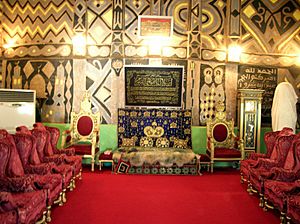Ado Bayero facts for kids
Quick facts for kids Ado Bayero |
|||||
|---|---|---|---|---|---|

Late Emir of Kano at early age.
|
|||||
| Emir of Kano | |||||
| Reign | 22 October 1963 – 6 June 2014 | ||||
| Predecessor | Muhammad Inuwa | ||||
| Successor | Muhammadu Sanusi II | ||||
| Heir presumptive | Sanusi Ado Bayero | ||||
| Born | 25 July 1930 Kano, Northern Region, British Nigeria |
||||
| Died | 6 June 2014 (aged 83) Kano, Nigeria |
||||
| Issue | Sanusi Ado Bayero Aminu Ado Bayero Nasiru Ado Bayero several others |
||||
|
|||||
| House | Dabo | ||||
| Father | Abdullahi Bayero | ||||
| Mother | Hajiya Hasiyatu (Mai Babban Daki) | ||||
| Religion | Islam | ||||
Ado Bayero was a very important leader in Nigeria. He was the Emir of Kano for a long time, from 1963 until 2014. An Emir is like a traditional king or ruler in some parts of Africa. He was known for his wisdom and for helping his people.
Contents
Early Life and Family
His Royal Family
Ado Bayero was born on July 25, 1930. He was part of the royal family of the Fulani Sullubawa clan. This family has ruled the Kano Emirate since 1819. His father was Abdullahi Bayero, who was also an Emir. His mother was Hajiya Hasiya. Ado Bayero was the eleventh child of his father.
His father ruled for 27 years. After his father, Ado Bayero's half-brother, Muhammadu Sanusi I, became Emir. He ruled from 1953 to 1963. Then, Muhammadu Inuwa was Emir for only three months.
His Education and Early Jobs
Ado Bayero started his education in Kano, where he learned about Islam. He then went to Kano Middle School, which is now called Rumfa College, Kano. He finished school in 1947.
After school, he worked at a bank for a few years. In 1949, he joined the Kano Native Authority, which was a local government body. He also went to Zaria Clerical College in 1952. In 1954, he was elected to the Northern regional House of Assembly. This was like being a representative in a government meeting.
From 1957 to 1962, he led the Kano Native Authority police. He worked hard to make sure people were not unfairly arrested. After this, he became Nigeria's Ambassador to Senegal. While there, he learned French.
His Time as Emir
Becoming Emir
After Emir Muhammadu Inuwa passed away, Ado Bayero was chosen as the new Emir of Kano. He was crowned on October 22, 1963. He became the 13th Fulani Emir of Kano. He was also the 56th ruler of Kano in total.
Challenges in the 1960s and 1970s
Ado Bayero became Emir when Nigeria was going through many changes. There were political shifts and some disagreements between different groups. In 1966, many political leaders from northern Nigeria died. This led to some violence, even in Kano. People who admired Bayero said he helped bring peace and stability during these difficult times.
During the 1960s and 1970s, military governments ruled Nigeria. These governments reduced some of the Emir's traditional powers. For example, the local police and prison departments that the Emir oversaw were removed. Also, new local government rules changed how much power the Emir had.
Later Years and Legacy
Ado Bayero believed in both Islamic learning and modern Western education. He encouraged people to get an education to succeed in Nigeria. He was also a strong voice against a group that caused trouble and opposed Western education.
In 2013, there was an attack on his motorcade. He survived, but some people were hurt, and his driver and bodyguard sadly passed away.
Ado Bayero passed away on June 6, 2014, at his palace. He had been Emir for 51 years, making him the longest-serving Emir in Kano's history.
He was seen as one of Nigeria's most respected Muslim leaders. He was also a successful businessman. He had worked in many different roles, including a banker, police officer, and diplomat. Ado Bayero was known for being a strong and powerful leader. He was also known for his wealth, which came from smart investments and farming.
Death and Succession
After Ado Bayero's death in 2014, there was a discussion about who would become the next Emir. His oldest son, Sanusi Ado Bayero, was expected to take his place. However, on June 8, 2014, his grand-nephew, Sanusi Lamido Sanusi, was crowned the new Emir of Kano.


